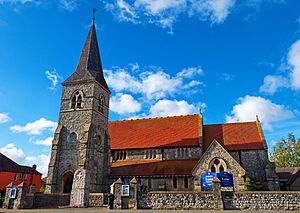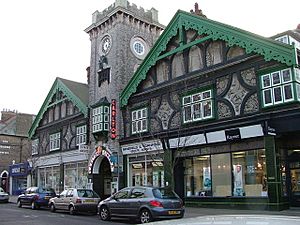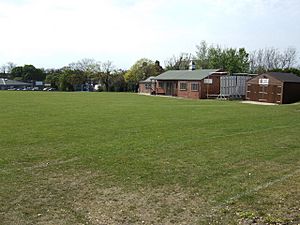Westgate-on-Sea facts for kids
Quick facts for kids Westgate-on-Sea |
|
|---|---|
 West Bay |
|
| Population | 6,996 (2011) |
| OS grid reference | TR321701 |
| Civil parish |
|
| District |
|
| Shire county | |
| Region | |
| Country | England |
| Sovereign state | United Kingdom |
| Post town | WESTGATE-ON-SEA |
| Postcode district | CT8 |
| Dialling code | 01843 |
| Police | Kent |
| Fire | Kent |
| Ambulance | South East Coast |
| EU Parliament | South East England |
| UK Parliament |
|
Westgate-on-Sea is a lovely seaside town in Kent, England. It has a population of about 7,000 people (as of 2011). The town is part of the Thanet area and is right next to the bigger town of Margate.
Westgate-on-Sea is famous for its two sandy beaches, which have been a popular spot for visitors since the 1860s. Back then, it grew from a small farming area into the town we know today.
During World War I, Westgate-on-Sea was home to an important Royal Naval Air Service seaplane base. This base helped protect the towns along the Thames Estuary. Many famous people have lived here, including the surgeon Sir Erasmus Wilson and archbishop of Canterbury William Temple. The artist Sir William Quiller Orchardson also painted some of his best works while living in Westgate.
Contents
Discovering Westgate-on-Sea's Past
Before the 1860s, Westgate was mostly farmland. There was a small coastguard station, built in 1791, and a few homes for its crew. These were located near the coast at St Mildred's Bay. This bay is named after Mildrith, who was a very important saint in Thanet long ago.
The town got its name from Westgate Manor, a large estate from medieval times. In the early 1900s, people found the remains of a Roman villa in what is now Beach Road. You can even see fresh water bubbling up from the sand at low tide there! More recently, other Roman sites have been found near Quex Park.
How Westgate Became a Seaside Town
In the late 1860s, clever business people decided to turn Westgate into a special seaside resort. They built a sea wall and promenade around St Mildred's Bay and West Bay. They sold plots of land to wealthy families from the city, creating an exclusive community by the sea.
When a railway station opened in 1871, more people moved to Westgate. The town grew quickly, reaching a population of 2,738 by 1901. To serve the growing community, two churches were built: St. James in 1872 and St. Saviour in 1884.
Many schools opened in Westgate during the late 1800s. Some of the biggest were Streete Court School and Wellington House Preparatory School. Famous people like Doctor Who actor Jon Pertwee and cabinet minister John Profumo attended Wellington House. Streete Court School was opened by John Vine Milne, the father of the famous author A. A. Milne.
Westgate During the World Wars
In 1903, the Coronation Bandstand was built by the cliffs to celebrate King Edward VII becoming king. A few years later, in 1904, a group of French nuns started the Ursuline Convent School, which is now Ursuline College.
When World War I began on August 1, 1914, a Royal Navy seaplane base opened on the coast. It helped protect the Thames Estuary from attacks. Later, a separate landplane base was opened in Manston, which eventually became Kent International Airport. During the war, the bandstand was used as sleeping quarters for soldiers. After the war, it became the Westgate Pavilion theatre.
By 1931, Westgate's population had grown to 4,554. During World War II, many schools in Westgate moved to safer places inland. On August 24, 1942, a German fighter pilot was captured after his plane crashed near the town. Later, on April 27, 1944, an American Liberator aircraft crashed off the beach, sadly killing five crew members.
After the wars, in 1975, five old church bells were moved to St Saviour's Church from Canterbury. Some of these bells are very old, with one dating back to the 14th century! The Westgate Pavilion, which had become a bingo hall, was later repaired by volunteers and reopened as a theatre in 2001.
Westgate's Location and Weather

Westgate-on-Sea is located in the northeast part of Kent, right on the coast of the Thames Estuary. It's next to Margate on one side and the village of Birchington-on-Sea on the other. The town sits by two sandy bays, St Mildred's Bay and West Bay. Both bays have a sea wall and structures called groynes to protect the coast from flooding. There are also chalk cliffs between and around the bays. The entire northeast Kent coast is a special protected area for nature.
Westgate is on the Isle of Thanet. This used to be a separate island from mainland Kent until about 200 years ago, when the water channel between them filled up with silt. The land in Thanet is mostly made of chalk, which formed when the area was under the sea a very long time ago.
Westgate's Climate
The warmest months in East Kent are July and August, when temperatures usually reach around 21°C (70°F). The coolest months are January and February, with temperatures averaging around 1°C (34°F). Westgate-on-Sea generally has slightly warmer temperatures than the national average.
The average yearly rainfall in East Kent is about 728 millimeters (28.7 inches). The wettest months are from October to January.
| Climate data for Wye Weather Station, Wye, Kent, England | |||||||||||||
|---|---|---|---|---|---|---|---|---|---|---|---|---|---|
| Month | Jan | Feb | Mar | Apr | May | Jun | Jul | Aug | Sep | Oct | Nov | Dec | Year |
| Mean daily maximum °C (°F) | 7.1 (44.8) |
7.2 (45.0) |
9.9 (49.8) |
12.1 (53.8) |
15.9 (60.6) |
18.7 (65.7) |
21.3 (70.3) |
21.6 (70.9) |
18.4 (65.1) |
14.5 (58.1) |
10.3 (50.5) |
8.0 (46.4) |
13.8 (56.8) |
| Mean daily minimum °C (°F) | 1.5 (34.7) |
1.3 (34.3) |
2.8 (37.0) |
4.3 (39.7) |
7.3 (45.1) |
9.9 (49.8) |
12.2 (54.0) |
12.2 (54.0) |
10.1 (50.2) |
7.2 (45.0) |
3.9 (39.0) |
2.6 (36.7) |
6.3 (43.3) |
| Average precipitation mm (inches) | 72.0 (2.83) |
44.7 (1.76) |
53.5 (2.11) |
50.8 (2.00) |
45.3 (1.78) |
51.8 (2.04) |
47.1 (1.85) |
55.9 (2.20) |
65.3 (2.57) |
85.4 (3.36) |
78.7 (3.10) |
77.3 (3.04) |
727.9 (28.66) |
| Source: Met Office | |||||||||||||
Because of its good climate and soil, Westgate is a great place for growing crops like wheat, potatoes, and beans. Many locals want to keep these fields for farming and not for building houses.
Getting Around Westgate
Westgate-on-Sea railway station connects the town to Ramsgate in East Kent and London Victoria. A fast train to London takes about 1 hour and 45 minutes. There are also National Express bus services to London.
Local Stagecoach buses run to nearby Birchington and Margate, and there's a service between Broadstairs and Canterbury that goes through Westgate-on-Sea. The A28 road also passes through Westgate, connecting it to places like Ashford and Canterbury.
People and Jobs in Westgate
| Westgate-on-Sea Compared | |||
|---|---|---|---|
| 2001 UK census | Westgate-on-Sea | Thanet District | England |
| Total population | 6,594 | 126,702 | 49,138,831 |
| Foreign born | 6% | 5% | 9% |
| White | 97% | 98% | 91% |
| Asian | 1% | 1% | 5% |
| Black | 0% | 0% | 2% |
| Christian | 76% | 74% | 72% |
| Muslim | 1% | 1% | 3% |
| Hindu | 0% | 0% | 1% |
| No religion | 14% | 16% | 15% |
| Over 65 years old | 27% | 22% | 16% |
| Unemployed | 4% | 4% | 3% |
In 2001, Westgate-on-Sea had 6,594 residents and 2,845 homes. Many homes were made up of single people, and a large number of residents were over 65 years old. This is common in seaside towns, as they are popular places for retirement.
Most people in Westgate are white (97.4% in 2001). The main religion is Christianity (75.8%).
How People Make a Living
Since Westgate is a seaside resort, a lot of its economy comes from tourism. There are many hotels and guest houses for visitors, especially in the summer. People also enjoy the shops and the beautiful coast and fields.
The town's High Street has various shops and services. There are also some factories. Because many older people live in Westgate, there are also many jobs in health and social care, like at local care homes. In 2001, about 7% of the population lived in a medical or care place, which is much higher than the national average.
Many people who live in Westgate work in retail (shops), health and social work, or manufacturing. Some people also work in construction, real estate, and education. Many residents travel outside the town for work.
Fun Things to Do in Westgate
Westgate-on-Sea has two lovely sandy beaches: St Mildred's Bay and West Bay. St Mildred's Bay is the bigger beach, where you can rent beach huts, deck chairs, and even jet-skis! It's also close to tennis courts and a golf putting course.
At West Bay, you'll find lots of small rock pools that are great for kids to explore. Both beaches have nearby cafés, restaurants, and pubs. They also share a European Blue Flag Award, which means they are clean and safe.
In the town centre, you can find charming Victorian shops, a library, and the three-screen Carlton Cinema. The Westgate Pavilion theatre also hosts discos, yoga, indoor bowls, and dance classes.
If you like golf, the Westgate and Birchington Golf Club has an 18-hole course on the cliffs between Westgate and Birchington. It was started in 1896. For cricket fans, the Westgate-on-Sea Cricket Club has teams that play on Saturdays and Sundays. In 2006, the local council opened a free skatepark at Lymington Road, designed by young people for skateboarders and inline skaters of all ages.
Local News and Radio
Newspapers
There are a few local weekly newspapers that cover news for the Thanet district. These include Isle Of Thanet KM Extra, Isle of Thanet Gazette, and Thanet Adscene. Some of these newspapers are free, while others you buy.
Radio
You can listen to KMFM Thanet on 107.2FM for local radio news and music. There's also a community radio station called Academy FM (Thanet) on 107.8FM, which started in 2010.





